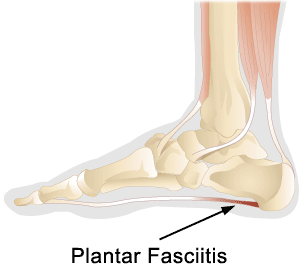Medical Library
Pick a Body Area
Plantar Fasciitis

Inflammation of the fascia on the bottom of the foot is the most common cause of heel pain.
There are many documented causes of plantar fasciitis. Poor flexibility of the calf muscles, no arch support, a sudden increase in one's level of activity, poor footwear, being overweight, excessive pronation, or repetitive stress conditions (long distance running). Common causes of a bruised heel bone are poor cushioning of the heel due to fat pad atrophy (shrinkage in the size of the fat pad) poor footwear, excessive walking on hard surfaces, and being overweight.
Depending on which medical study you read, anywhere form 8-21% of the population suffers from plantar fasciitis. The pain is typically located at the front of the base of the calcaneus. Less often, the pain extends along the arch of the foot. The result is micro-tearing of the plantar fascia where it attaches to the base of the calcaneus. An ensuing inflammatory response occurs producing pain, swelling, warmth, loss of function (difficulty with any standing or walking), and less often, redness.
Plantar fasciitis is often worst in the morning when one takes his /her first steps out of bed. Theories propose that when we are sleeping, the inflamed fascia is shortening and perhaps attempting to heal. If the problem is chronic, a bone spur may be seen on x-ray.
Currently, we believe that a bone spur is not the cause of the pain but the result of the body's attempt to heal the damaged plantar fascia.
Possible Treatments
- Ankle Active Range of Motion Video
- Ankle Joint Mobilization Video
- Ankle Joint Passive Range of Motion Video
- Ankle Progressive Resistive Range of Motion Video
- Cryotherapy or Cold Therapy Video
- Electrotherapeutic Modalities
- Gait or Walking Training Video
- Isometric Exercise Video
- Iontophoresis
- Proprioception Exercises Video
- Physical Agents
- Soft Tissue Mobilization Video
- Stretching/Flexibility Exercise Video
- Ankle Active Range of Motion
Possible Treatment Goals
- Improve Balance
- Decrease Risk of Reoccurrence
- Improve Fitness
- Improve Function
- Improve Muscle Strength and Power
- Increase Oxygen to Tissues
- Improve Proprioception
- Improve Range of Motion
- Self-care of Symptoms
- Improve Tolerance for Prolonged Activities
Additional Resources
Disclaimer
The information in this medical library is intended for informational and educational purposes only and in no way should be taken to be the provision or practice of physical therapy, medical, or professional healthcare advice or services. The information should not be considered complete or exhaustive and should not be used for diagnostic or treatment purposes without first consulting with your physical therapist, occupational therapist, physician or other healthcare provider. The owners of this website accept no responsibility for the misuse of information contained within this website.

